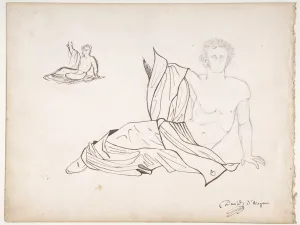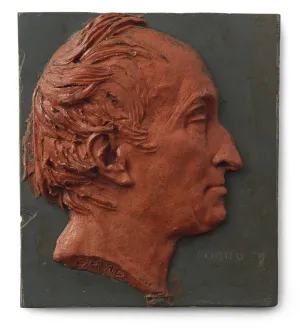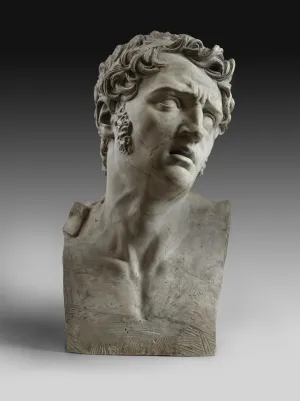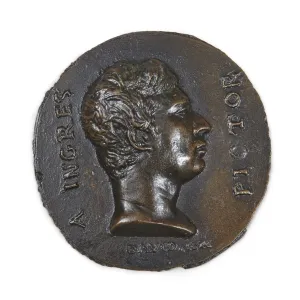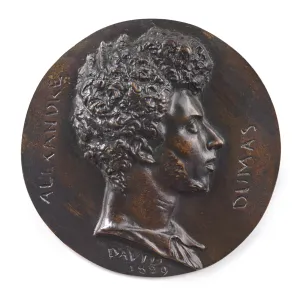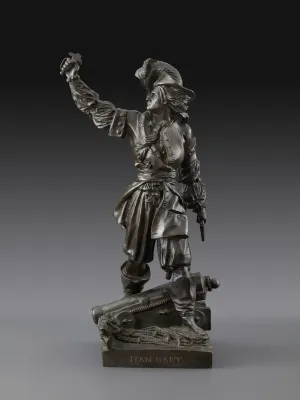Complete Checklist
Study after a Plaster Cast of the Apollo Belvedere, ca. 1814
Black chalk on laid paper
32 x 34.5 cm
Signed and dedicated lower right in David’s hand, David à son ami Cuvier; inscribed lower left in a different hand, N. 87-1814
Collection Louise Grunwald
Cat. 1
Long considered an exemplar of ideal classical beauty, the full-length ancient marble statue known as the Apollo Belvedere (Vatican Museums, Rome) was widely copied by early nineteenth-century art students. In this drawing, possibly a comment on the distance between the classical tradition and modern life, David shows only the face of the god, lying across the page like a fragmented artifact or death mask.
General Bonchamps Shown in a Pose Designed for His Tomb (recto), 1824
Graphite, pen, and brown ink (recto); graphite (verso)
21.4 x 28 cm
Signed lower right
The Metropolitan Museum of Art, New York;
Purchase, Karen B. Cohen Gift, 1989 (1989.286.1)
Cat. 2
A prolific draftsman, David often made multiple preliminary sketches for his sculptures. This schematic drawing outlines the composition of his Monument to Bonchamps (1824), a reduced bronze version of which is exhibited nearby. David references an ancient Greek sculpture of a river god from the recently discovered Elgin marbles (British Museum), which he had seen in London in 1816 (see below).
Head of a Woman in Profile, ca. 1830s
Graphite on paper
20.6 x 15.8 cm
Estate stamp, lower left
The Cleveland Museum of Art; Gift of the Painting and Drawing Society of The Cleveland Museum of Art (2000.40)
Cat. 3
This sensitive rendering is an amalgam of classicism and closely observed nature. Delicate hatching indicates the contours of the face, with a subtle emphasis on the outline of the profile — particularly the bridge of the nose and the slightly parted lips. This contrasts with the boldly marked strokes of the sitter’s hair, with its upward serpentine swirl continued by the curve of the hair comb. David valued profile views for their ability to quickly and accurately describe an individual. “The profile,” he wrote, “is unity.”
Portrait of A. W. von Schlegel, 1834
Graphite on paper
26 x 16 cm
Inscribed in David’s hand, A. W. von Schlegel / dessiné par David d’Angers à Bonn en
New York Public Library; S. P. Avery Collection, The Miriam and Ira D. Wallach Division of Art, Prints, and Photographs
Cat. 4
This precise likeness of the Romantic writer A. W. von Schlegel (1767–1845) was executed from life during David’s second trip to Germany in 1834. Particular care is taken with Schlegel’s profile, which would be the crucial element of the corresponding portrait medallion. According to the sculptor, his motives for making the portrait were “the brutal ingratitude of young Germans for the old man, and … the interest I have gained from reading his works on art.”
Study for a Tomb Relief for the Duchess d’Abrantès, 1841
Graphite on papier calque laid on mulberry paper
22.1 x 20 cm
Signed, dated, and inscribed in brown ink at bottom in David’s hand, Projet de bas relief pour le monument de Mme. D’Abrantès.
Collection Dr. and Mrs. Michael Schlossberg
Cat. 5
In the nineteenth century, the achievements of women were rarely acknowledged by public monuments. Shown here is David’s unexecuted design for a tomb relief commemorating Laure Junot, Duchess of Abrantès (1784–1838). The duchess, wife of a Napoleonic general and later Balzac’s lover, is shown writing her famous memoirs. Standing before her are Napoleon and a group of his generals, including her husband. David developed an original and expressive relief style. His bas-reliefs, as indicated by this drawing, focus on legibility and reject the elaborate perspectival conceits of painting.The Four Sergeants of La Rochelle, 1844
Graphite on paper
20 x 17.4 cm (sheet size)
Private collection
Cat. 6
Émile Deschamps, 1829
Wax on slate
13.3 x 12.1 cm
Collection Carol and Herbert Diamond
Cat. 7
Seated Woman, ca. 1830s
Terracotta
19 x 15.5 cm
Collection Dr. and Mrs. Michael Schlossberg
Cat. 8
David had little patience for the eroticized mythological nudes that jostled for attention each year at the Paris Salon. Accordingly, this elegant terracotta sketch depicts a woman in modern dress, possibly interrupted in the act of reading. Yet this apparently everyday moment may also be an update of the centuries-old pictorial convention of seated muses. For David, terracotta sketches were important records of an artist’s first thoughts. He presented them only to close friends who he believed could appreciate their suggestive, unfinished qualities.
The Abbé de Lamennais, 1831
Wax on slate
16.5 x 14 cm
Private collection
Cat. 9
Pierre-René Choudieu, 1832
Wax on slate
14 x 12.4 cm
Collection Dr. Stephen K. and Janie Woo Scher
Cat. 10
“I pursue always my gallery of great men,” wrote David in 1830–31. “One sees me, running with my little slate, as if I were going to meet immortality.” The city of Angers was well known for its local slate quarries, and David used the stone as a support for his wax models. In this portrait of a Republican politician and prosecutor, the deep blue-green slate provides a lively contrast to the vibrant red of the tinted wax. David’s interest in portraiture reflects the dramatic increase in popularity of that genre in the early nineteenth century.
Christening Cup, 1835
Wood, wax, and graphite
18.9 cm high
Collection Pierre Bergé
Cat. 11
Model for the Philopoemen, 1837
Terracotta
31 x 10.5 x 10.3 cm
Inscribed in ink on base, à Victor Pavie
Collection Roberta J. M. Olson and Alexander B. V. Johnson
Cat. 12
La Douleur (Pain), 1811
Plaster
54 x 32 x 26 cm
Dated front, lower right
Collection Roberta J. M. Olson and Alexander B. V. Johnson
Cat. 12
This extraordinary bust won the 1811 tête d’expression (expressive head) competition at the École des Beaux-Arts in Paris. Its originality lies in the artist’s conjunction of classical sculptural types with his close study of a posed, fashionably sidewhiskered model. La Douleur marks the beginning of David’s lifelong exploration of the relationship between ideal classical beauty and the fleshy reality of the living body. One of two casts made during his lifetime, the work retains the raised seams from its original molds.
Victor Schnetz, 1828
Plaster cast
12 cm diameter
Collection Dr. Stephen K. and Janie Woo Scher
Cat. 14
French painter (1787–1870)
Robert David, 1834
Patinated plaster
23.5 cm diameter
Collection Carol and Herbert Diamond
Cat. 15
Christening Cup (after an 1835 model)
Patinated plaster
18.9 cm high
Signed and dated, 1854; inscribed, patria
Collection Roberta J. M. Olson and Alexander B. V. Johnson
Cat. 16
Hélène David, 1838
Plaster Inscribed and dedicated in David’s hand in ink on reverse, à Victor Pavie
26.7 cm diameter
Collection Carol and Herbert Diamond
Cat. 17
Ann Buchan Robinson, 1831
Marble
48.89 x 22.86 x 19.05 cm
Signed and dated
Museum of the City of New York;
Gift of J. Philip Benkard II, 1958 (58.369.3)
Cat. 18
One of the first works by David to enter an American collection, this privately commissioned portrait depicts the wife of Captain Henry Robinson (1782–1866), who operated a shipping firm between New York and Le Havre. David executed comparatively few busts of women, none of which exhibit the expressive intellect of his portraits of men. The bust of Ann Robinson is as coolly contained as the marble from which she is carved.
The Grand Condé, 1817
Bronze
35.6 x 17.5 x 14 cm
Private collection
Cat. 19
In 1816, David received a commission for a statue commemorating the seventeenth-century French general known as the Grand Condé (1621–1683). In this, his first major state commission, David defied the conventional repose and heroic nudity of neoclassicism. Presenting a figure garbed in extravagant historical costume and engaged in dramatic action, The Grand Condé captures a pivotal episode when the general hurled his commander’s baton at the enemy before leading his troops forward to reclaim it.
Monument to Bonchamps, 1824
Bronze
19.7 x 22.9 x 14 cm
Inscribed on front of base, Grâce pour les prisonniers, Bonchamp le veut; on rear of base, Froment-Meurice ciseleur à son ami Wasselin Desfosses 14 Juin 1854
Collection Dr. and Mrs. Michael Schlossberg
Cat. 20
This statuette is a reduced version of David’s marble statue commemorating Charles-Artus de Bonchamps (1760– 1793), a royalist general who died in the aftermath of the French Revolution (Church of Saint Florent-le-Vieil, Maineet- Loire). A critical success at the Paris Salon of 1824, the sculpture depicts the mortally wounded general delivering his last words: a command for his troops to spare the lives of their Republican prisoners. The subject held personal significance for David, whose father had been among the captured soldiers.
Jean-Antoine-Dominique Ingres, 1826
Bronze, irregular edges
9.7 cm diameter
Collection Dr. and Mrs. Michael Schlossberg
Cat. 21
François-Marius Granet, 1827
Bronze
12.8 cm diameter
Collection W. Mark Brady, New York
Cat. 22
Cecilia Odescalchi, ca. 1828
Bronze
15.5 cm diameter
Inscribed, roma; dated, 1815; stamped on reverse, 349
Private collection
Cat. 23
This idealized portrait medallion records the features of David’s first love, Cecilia Odescalchi, a young noblewoman he met while studying in Rome (1812–16). Their ill-fated relationship concluded abruptly with Cecilia’s removal to a convent, where she soon died. Although dated 1815, the portrait is adapted from a bas-relief made by the artist in 1828. Even in death, Cecilia remained David’s muse, and her likeness can be found in many of his sculptures, including the Christening Cup.
Eugène Delacroix, 1828
Bronze
10.5 cm diameter
Foundry mark, Richard
Private collection
Cat. 24
Victor Hugo, 1828
Bronze
10.7 cm diameter
Foundry mark, Eck et Durand
Collection Frances Beatty and Allen Adler
Cat. 25
French poet, novelist, and dramatist (1802–1885)
Émile Deschamps, 1829
Bronze
12 cm diameter
Collection Carol and Herbert Diamond
Cat. 26
Alexandre Dumas, 1829
Bronze
15 cm diameter
Foundry marks, Richard frères; Eck et Durand; stamped on reverse, 165
Private collection
Cat. 27
French novelist (1802–1870)
Frédéric Louis Zacharie Werner, ca. 1830s
Bronze
15 cm diameter
Private collection
Cat. 28
German dramatist and poet (1768–1823)
Théodore Géricault, 1830
Bronze
14.8 cm diameter
Stamped on reverse, three illegible nos.
Collection Wheelock Whitney III
Cat. 29
French painter (1791–1824)
Louise Swanton-Belloc, 1830
Lead or pewter
13 cm diameter
Collection Dr. Stephen K. and Janie Woo Scher
Cat. 30
French novelist (1796–1881)
Alfred de Musset, 1831
Bronze
15.9 cm diameter
Collection Frances Beatty and Allen Adler
Cat. 31
French poet and playwright (1810–1857)
The Abbé de Lamennais, 1831
Bronze
Approximately 15.5 cm diameter
Private collection
Cat. 32
François Arago, 1832
Bronze
15 cm diameter
Private collection
Cat. 33
French astronomer, mathematician, and politician (1786–1853)Ludwig Tieck, 1834
Bronze
31.1 cm high
Signed and dated; inscribed on front of base, L TIECK.
The Metropolitan Museum of Art, New York;
Gift of Joseph G. Reinis (1997.393)
Cat. 34
David made several international trips in order to meet and render homage to illustrious men and women. In 1834, during his second sojourn in Germany, he modeled a colossal portrait head of the poet and translator Ludwig Tieck (1773–1853). He also produced this depiction of the seated writer. David enjoyed conversing with his famous sitters, and Tieck is captured in the midst of a lively discussion.
Caspar David Friedrich, 1834
Bronze
Approximately 17.7 cm diameter
Foundry mark, Eck et Durand; stamped on reverse, 321
Private collection
Cat. 35
German painter (1774–1840)
Niccòlo Paganini, 1834
Bronze
15.6 cm diameter
Collection Dr. and Mrs. Michael Schlossberg
Cat. 36
Italian musician and composer (1782–1840)
Christening Cup (after an 1835 model)
Bronze
18.3cm high
Signed and dated, 1854; inscribed, patria
Collection Pierre Bergé
Cat. 37
Mélanie Waldor, 1835
Bronze
13.3 cm diameter
Collection Dr. Stephen K. and Janie Woo Scher
Cat. 38
French poet and novelist (1796–1871)
Philopoemen, 1837
Bronze
34.9 x 13.3 x 16.5 cm
Foundry mark, Thiébaut Frères
Collection Dr. and Mrs. Michael Schlossberg
Cat. 39
Ambroise Paré, 1840
Bronze
47.7 x 20.7 x 17.1 cm
Inscribed underneath base, 29; on base, AMBROISE PARÉ
Foundry mark, F. Barbedienne
Collection Carol and Herbert Diamond
Cat. 40
“Gesture,” wrote David, “is the language of sculpture.” The sculptor’s maxim is well illustrated by this reduced bronze after his statue of Ambroise Paré, the famous French military doctor and pioneer of modern surgery. The challenge posed by the subject was to simultaneously communicate his qualities of action and thought. David’s elegant solution uses the expressive potential of the human body, creating a vibrant interplay between action and repose.
Liberty, 1839
Bronze
23.8 cm high
Signed and dated; inscribed on front of base, LIBERTÉ LIBERTÉ CHÉRIE / COMBATS AVEC TES DÉFENSEUR (LIBERTY, CHERISHED LIBERTY / FIGHT WITH YOUR DEFENDERS); stamped on base, 57
Foundry mark, Thiébaut frères
Collection Dr. and Mrs. Michael Schlossberg
Cat. 41
An outspoken Republican (for which he was arrested and exiled by Napoleon III), David produced many allegorical likenesses of Liberty. Both of these works envisage her as a militant figure, bearing a rifle and bayonet. In The Massacres of Galicia, Liberty also assumes the role of Clio, muse of history, vengefully inscribing the names of political villains on a gallows. Each work was designed for reproduction and broad distribution, like printed political tracts or religious icons.
The Four Sergeants of La Rochelle (uniface, obverse), ca. 1844
Bronze
8.9 cm diameter
Private collection
Cat. 42
The Four Sergeants of La Rochelle (uniface, reverse), ca. 1844
Bronze
8.9 cm diameter
Private collection
Cat. 43
Jean Bart, 1845
Bronze
41.8 x 22 x 14.5 cm
Signed and dated, 1845; on base, JEAN BART.
Foundry mark, Eck et Durand
Private collection
Cat. 44
This statuette is a reduced version of David’s gigantic, rousing bronze monument to Jean Bart (1650–1702), a French naval commander and privateer. Bart raises his sword (lost) as he tramples an enemy cannon at his feet. His sailor’s costume whips and curls in the wind, producing an energetic surface and delineating a human form that deviates from the idealized proportions of the classical nude body. David’s monuments were intended to educate and inspire and drew upon nationalism and local pride.The Massacres of Galicia (obverse), 1846
Bronze
7.2 cm diameter
Private collection
Cat. 45
Rosa Bonheur, 1854
Bronze
17 cm diameter
Private collection
Cat. 46
French painter (1822–1899)
Les Médaillons de David d’Angers
(Paris: Ch. Lahure, 1867)
Book, 447 albumen prints attributed to Étienne Carjat
Private collection
Cat. 47
Les Médaillons de David d’Angers. Collection de 125 Planches, accompagnée d’un portrait de David d’Angers, gravé d’après d’Hebert, et précédée d’une Préface par Émile-Soldi (Paris: A. Lévy, 1883)
Book, 125 plates
American Numismatic Society
Cat. 48


